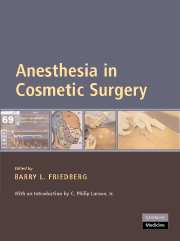Book contents
- Frontmatter
- Contents
- Foreword
- Acknowledgments
- Introduction
- Preface
- List of Contributors
- PART I MINIMALLY INVASIVE ANESTHESIA (MIA)Ⓡ FOR MINIMALLY INVASIVE SURGERY
- PART II ALTERNATIVE ANESTHESIA APPROACHES IN COSMETIC SURGERY
- PART III OTHER CONSIDERATIONS FOR ANESTHESIA IN COSMETIC SURGERY
- 14 Preanesthetic Assessment of the Cosmetic Surgery Patient
- 15 Psychological Aspects of Cosmetic Surgery
- 16 The Business of Office-Based Anesthesia for Cosmetic Surgery
- 17 The Politics of Office-Based Anesthesia
- 18 Staying Out of Trouble: The Medicolegal Perspective
- APPENDIX A A Guide to Perioperative Nutrition
- APPENDIX B Reflections on Thirty Years as an Expert Witness
- Index
- References
15 - Psychological Aspects of Cosmetic Surgery
from PART III - OTHER CONSIDERATIONS FOR ANESTHESIA IN COSMETIC SURGERY
Published online by Cambridge University Press: 22 August 2009
- Frontmatter
- Contents
- Foreword
- Acknowledgments
- Introduction
- Preface
- List of Contributors
- PART I MINIMALLY INVASIVE ANESTHESIA (MIA)Ⓡ FOR MINIMALLY INVASIVE SURGERY
- PART II ALTERNATIVE ANESTHESIA APPROACHES IN COSMETIC SURGERY
- PART III OTHER CONSIDERATIONS FOR ANESTHESIA IN COSMETIC SURGERY
- 14 Preanesthetic Assessment of the Cosmetic Surgery Patient
- 15 Psychological Aspects of Cosmetic Surgery
- 16 The Business of Office-Based Anesthesia for Cosmetic Surgery
- 17 The Politics of Office-Based Anesthesia
- 18 Staying Out of Trouble: The Medicolegal Perspective
- APPENDIX A A Guide to Perioperative Nutrition
- APPENDIX B Reflections on Thirty Years as an Expert Witness
- Index
- References
Summary
INTRODUCTION
According to the American Society of Plastic Surgeons (ASPS), over fifteen million Americans underwent a plastic surgical procedure in 2003. The majority of plastic surgical procedures consisted of relatively new, minimally invasive, nonsurgical procedures. These numbers, while familiar to many plastic surgeons, are often staggering to other medical professionals and lay persons who have little idea of the number of Americans who turn to medicine to enhance their physical appearance. Nevertheless, these numbers likely underestimate the number of procedures performed annually, as they do not account for nonplastic surgeon physicians who offer these treatments. In particular, the preceding numbers do not reflect the surgical activity of either the American Academy of Cosmetic Surgeons (AACS) or the American Society of Dermatologic Surgeons (ASDS).
The growth in popularity of cosmetic surgery and related treatments can be attributed to several factors. Changes in the medical and surgical communities, including improvements in safety and direct-to-consumer marketing, have likely contributed to the growth. The mass media and entertainment industries have long championed cosmetic surgery, perhaps no more so than during the current era of “reality-based” television programs such as “Extreme Makeover” and “The Swan.” The virtually inescapable bombardment of mass-media ideals of beauty, coupled with the discontent that many people, particularly women, experience with regard to their physical appearance, have likely contributed as well.
- Type
- Chapter
- Information
- Anesthesia in Cosmetic Surgery , pp. 182 - 198Publisher: Cambridge University PressPrint publication year: 2007
References
- 1
- Cited by

